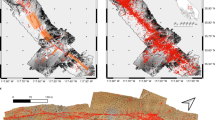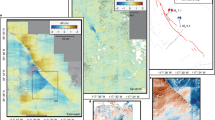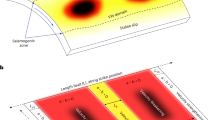Abstract
Surface-rupture patterns and aftershock distributions accompanying moderate to large shallow earthquakes reveal a residual brittle infrastructure for established crustal fault zones, the complexity of which is likely to be largely scale-invariant. In relation to such an infrastructure, continued displacement along a particular master fault may involve three dominant mechanical processes of rock brecciation: (a)attrition brecciation, from progressive frictional wear along principal slip surfaces during both seismic and aseismic sliding, (b)distributed crush brecciation, involving microfracturing over broad regions when slip on the principal slip surfaces is impeded by antidilational jogs or other obstructions, and (c)implosion brecciation, associated with the sudden creation of void space and fluid-pressure differentials at dilational fault jogs during earthquake rupture propagation. These last, high-dilation breccias are particularly favorable sites for hydrothermal mineral deposition, forming transitory low-pressure channels for the rapid passage of hydrothermal fluids. Long-lived fault zones often contain an intermingling of breccias derived from all three processes.
Similar content being viewed by others
References
Aydin, A. andJohnson, A. M. (1978),Development of faults as zones of deformation bands and as slip surfaces in sandstone. Pure Appl. Geophys.116, 931–942.
Booker, J. (1974),Time-dependent strain following faulting of a porous medium. J. Geophys. Res.79, 2037–2043.
Bouchon, M. (1982),The rupture mechanism of the Coyote Lake earthquake of 6 August 1979 inferred from near-field data. Bull. Seism. Soc. Am.72, 745–757.
Brock, W. G. andEngelder, J. T. (1977),Deformation associated with the movement of the Muddy Mountain overthrust in the Buffington window, southeastern Nevada. Geol. Soc. Am. Bull.88, 1667–1677.
Burdick, L. J. andMellman, G. R. (1976),Inversion of body waves from Borrego Mountain earthquake to the source mechanism. Bull. Seism. Soc. Am.66, 1485–1499.
Byerlee, J., Mjachkin, V., Summers, R. andVoevoda, O. (1978),Structures developed in fault gouge during stable sliding and stick-slip. Tectonophys.44, 161–171.
Chester, F. M., Friedman, M., andLogan, J. M. (1985),Foliated cataclasite. Tectonophys.111, 134–146.
Clark, M. M. (1972),Surface rupture along the Coyote Creek fault. U.S. Geol. Surv. Prof. Paper787, 55–86.
Crowell, J. C. (1974),Origin of Late Cenozoic basins in southern California. Soc. Econ. Pal. Mineral. Spec. Publ.22, 190–203.
Das, S. andScholz, C. H. (1981),Off-fault aftershock clusters caused by shear stress increase. Bull. Seism. Soc. Am.71, 1669–1675.
Davis, G. A., Anderson, J. L., Frost, E. G. andShackelford, T. J. (1980),Mylonitization and detachment faulting in the Whipple-Buckskin-Rawhide Mountains terrane, southeastern California and western Arizona. Geol. Soc. Am. Mem.153, 79–129.
Eaton, J. P., O'Neill, M. E., andMurdock, J. N. (1970),Aftershocks of the 1966 Parkfield-Chola California, earthquake: A detailed study. Bull. Seism. Soc. Am.60, 1151–1197.
Ebel, J. E. andHelmberger, D. V. (1982),P-wave complexity and fault asperities: The Borrego Mountain, California, earthquake of 1968. Bull. Seism. Soc. Am.72, 413–437.
Engelder, J. T. (1974),Cataclasis and the generation of fault gouge. Geol. Soc. Am. Bull.85, 1515–1522.
Engelder, J. T. (1978),Aspects of asperity-surface interaction and surface damage of rocks during experimental frictional sliding. Pure Appl. Geophys.116, 705–716.
Engelder, J. T., Logan, J. M., andHandin, J. (1975),The sliding characteristics of sandstone on quartz fault-gouge. Pure Appl. Geophys.113, 69–86.
Etheridge, M. (1983),Differential stress magnitudes during regional deformation and metamorphism: Upper bound imposed by tensile fracturing. Geology11, 231–234.
Flinn, D. (1977),Transcurrent faults and associated cataclasis in Shetland. J. Geol. Soc. Lond.133, 231–248.
Gamond, J. F. (1983),Displacement features associated with fault zones: A comparison between observed examples and experimental models. J. Struct. Geol.5, 33–46.
Gay, N. C. andOrtlepp, W. D. (1979),Anatomy of a mining-induced fault zone. Geol. Soc. Am. Bull.90, 47–58.
Grocott, J. (1981),Fracture geometry of pseudotachylyte generation zones: A study of shear fractures formed during seismic events. J. Struct. Geol.3, 169–178.
Hamilton, R. M. (1972),Aftershocks of the Borrego Mountain earthquake from April 12 to June 12, 1968. U.S. Geol. Surv. Prof. Paper787, 31–54.
Hill, D. P. (1977),A model for earthquake swarms. J. Geophys. Res.82, 1347–1352.
House, W. M. andGray, D. R. (1982),Cataclasites along the Saltville thrust, U.S.A., and their implications for thrust-sheet emplacement. j. Struct. Geol.4, 257–269.
Hulin, C. D. (1929),Structural control of ore deposition. Econ. Geol.24, 15–49.
Jackson, R. E. andDunn, D. E. (1974),Experimental sliding friction and cataclasis of foliated rocks. Int. J. Rock Mech. Min. Sci.14, 235–249.
King, G. C. P. (1983),The accommodation of large strains in the upper lithosphere of the earth and other solids by self-similar fault systems: The geometrical origin of b-value. Pure Appl. Geophys.121, 762–815.
Liu, H.-L. andHelmberger, D. V. (1983),The near-source ground motion of the 6 August 1979 Coyote Lake, California, earthquake. Bull. Seism. Soc. Am.73, 201–218.
Masson, H. (1972),Sur l'origine de la cornieule par fracturation hydraulique. Eclogae geol. Helv.65, 27–41.
McKibben, M. A. andElders, W. A. (1985),Fe−Zn−Cu−Pb mineralization in the Salton Sea geothermal system, Imperial Valley, California. Econ. Geol.80, 539–559.
McKinstry, H. E.,Mining Geology. Prentice-Hall, New Jersey, 1948, 677 pp.
Mitcham, T. W. (1974),Origin of breccia pipes. Econ. Geol.69, 412–413.
Moore, H. E. andSibson, R. H. (1978),Experimental thermal fragmentation in relation to seismic faulting. Tectonophys.49, T9–T17.
Muraoka, H. andKamata, H. (1983),Displacement distributions along minor fault traces. J. Struct. Geol.5, 483–495.
Newhouse, W. H.,Ore Deposits as Related to Structural Features. Princeton Univ. Press, New Jersey, 1942, 280 pp.
Nur, A., andBooker, J. (1972),Aftershocks caused by pore fluid flow?. Science175, 885–887.
Paterson, M. S.,Experimental Rock Deformation — The Brittle Field. Springer-Verlag, Berlin, 1978, 254 pp.
Phillips, W. J. (1972),Hydraulic fracturing and mineralization. J. Geol. Soc. Lond.128, 337–359.
Reasenberg, P. andEllsworth, W. L. (1982),Aftershocks of the Coyote Lake, California, earthquake of August 6, 1979: A detailed study. J. Geophys. Res.87, 10, 637–10, 665.
Redwine, L (1981),Hypothesis containing dilation, natural hydraulic fracturing and dolomitisation to explain petroleum reservoirs in Monterey Shale, Santa Maria area, California, inThe Monterey Formation and Related Siliceous Rocks of California. R. E. Garrison, R. G. Douglas, K. E. Pisciotto, C. M. Isaacs and J. C. Ingle (eds.), Spec. Publ. Soc. Econ. Pal. Mineral., Los Angeles, p. 221–248.
Robertson, E. C. (1982),Continuous formation of gouge and breccia during fault displacement, inIssues in Rock Mechanics. Proc. 23rd Symp. Rock Mechanics, R. E. Goodman and F. E. Heuse (eds.), Am. Inst. Mining Metall. Petrol. Eng., New York, 397–403.
Roehl, P. O. (1981), ‘Dilation brecciation —A proposed mechanism of fracturing, petroleum expulsion and dolomitization in the Monterey Formation, California’, inThe Monterey Formation and Related Siliceous Rocks of California. R. E. Garrison, R. G. Douglas, K. E. Pisciotto, C. M. Isaaca, and J. C. Ingle (eds.), Spec. Publ. Soc. Econ. Pal. Mineral., Los Angeles, p. 285–315.
Segall, P. andPollard, D. D. (1980),Mechanics of discontinuous faulting. J. Geophys. Res.85, 4337–4350.
Segall, P. andPollard, D. D. (1983),Nucleation and growth of strike-slip faults in granite. J. Geophys. Res.88, 555–568.
Sharp, W. E. (1965),The deposition of hydrothermal quartz and calcite. Econ. Geol.60, 1635–1644.
Sibson, R. H. (1975),Generation of pseudotachylyte by ancient seismic faulting. Geophys. J. R. Astr. Soc.43, 775–794.
Sibson, R. H. (1977),Fault rocks and fault mechanisms. J. Geol. Soc. Lond.133, 191–213.
Sibson, R. H. (1983),Continental fault structure and the shallow earthquake source. J. Geol. Soc. Lond.140, 741–767.
Sibson, R. H. (1985),Stopping of earthquake ruptures at dilational fault jogs. Nature316, 248–251.
Sibson, R. H. (1986),Rupture interaction with fault jogs, inEarthquake Source Mechanics. S. Das, J. Boatwright and C. H. Scholz (eds.), Maurice Ewing Ser. 6, Am. Geophys. Union Mon. 37, 157–168.
Sieh, K. E. (1978),Slip along the San Andreas fault associated with the great 1857 earthquake. Bull. Seism. Soc. Am.68, 1421–1448.
Spurr, J. E. (1925),The Camp Bird compound veindike. Econ. Geol.20, 115–152.
Tchalenko, J. S. (1970),Similarities between shear zones of different magnitudes. Geol. Soc. Am. Bull.81, 1625–1640.
Tchalenko, J. S. andBerberian, M. (1975),Dasht-e Bayaz Fault, Iran: Earthquake and earlier related structures in bed rock. Geol. Soc. Am. Bull.86, 703–709.
Toulmin, P. andClark, S. P. (1979),Thermal aspects of ore formation, inGeochemistry of Hydrothermal Ore Deposits. H. L. Barnes (ed.), Holt, Rinehart, New York, 437–464.
Vedder, J. G. andWallace, R. E. (1970),Map showing recently active fault breaks along the San Andreas and related faults between Cholame Valley and Tejon Pass, California. U.S. Geol. Surv. Misc. Invest. Map I-574, scale 1∶24,000.
Wilkins, J. andHeidrick, T. L. (1982),Base and precious metal mineralization related to low-angle tectonic features in the Whipple Mountains, California, and Buckskin Mountains, Arizona, inMesozoic-Cenozoic Tectonic Evolution of the Colorado River Region, California, Arizona and Nevada. E. G. Forst and D. L. Martin (eds.), Cordilleran Publishers, San Diego, p. 182–203.
Author information
Authors and Affiliations
Rights and permissions
About this article
Cite this article
Sibson, R.H. Brecciation processes in fault zones: Inferences from earthquake rupturing. PAGEOPH 124, 159–175 (1986). https://doi.org/10.1007/BF00875724
Received:
Revised:
Accepted:
Issue Date:
DOI: https://doi.org/10.1007/BF00875724




